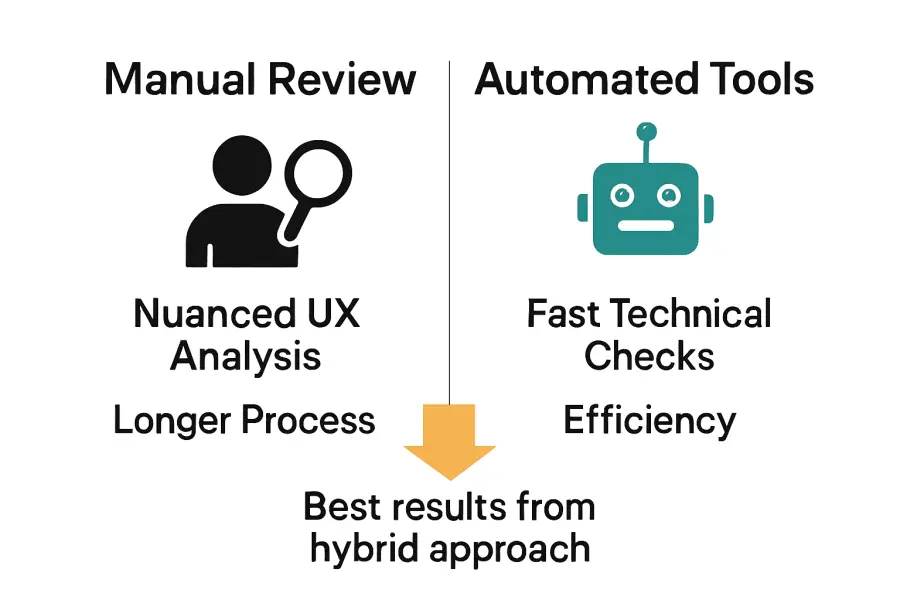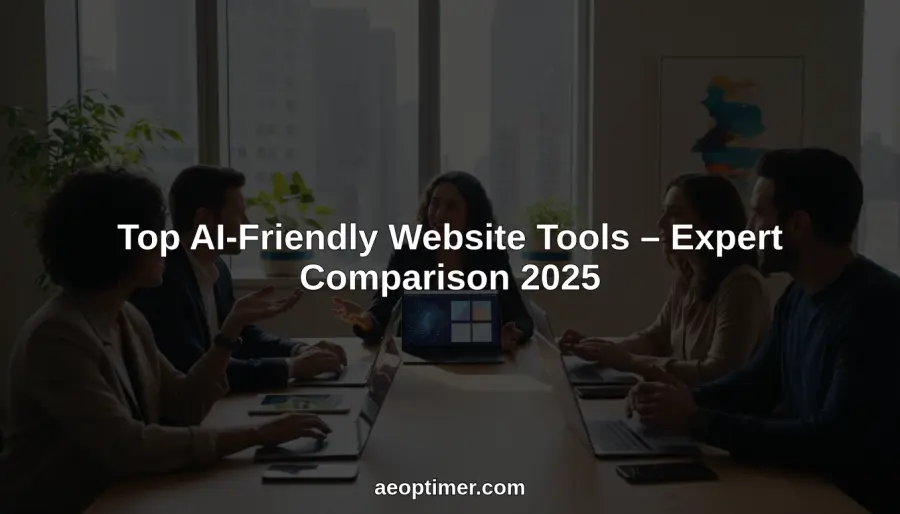Manual Review in Website Optimization Explained

Did you know that websites improved by hands-on human review enjoy up to 30 percent greater user engagement compared to those using only automated tools? For online businesses and creators, digital performance can make or break success. A manual website review uncovers the subtle issues and user experience gaps that machines often miss, offering the kind of insight that helps sites attract, engage, and keep more visitors.
Table of Contents
- Manual Review In Website Optimization Defined
- Types Of Manual Website Reviews And Differences
- Step-By-Step Process Of Conducting Manual Review
- Common Pitfalls And Quality Assurance Checks
- Deciding Between Manual And Automated Review
Key Takeaways
| Point | Details |
|---|---|
| Importance of Manual Reviews | Manual reviews provide nuanced insights into website performance that automated tools often miss, enhancing accessibility and usability. |
| Types of Manual Reviews | Different manual review types, including health, security, competitive, and content audits, address specific organizational needs and digital challenges. |
| Holistic Optimization Process | A successful optimization strategy should integrate both manual and automated reviews to achieve comprehensive website performance improvements. |
| Risk Management | Vigilant quality assurance is essential to prevent pitfalls like spamdexing and to ensure content authenticity and user engagement. |
Manual Review in Website Optimization Defined
A manual review in website optimization represents a critical human-driven assessment designed to evaluate and improve a website’s digital performance. According to research from independent web services, this process involves a comprehensive examination where human evaluators meticulously assess a website’s accessibility, usability, and search engine optimization capabilities to identify potential enhancement opportunities.
Unlike automated scanning tools, manual reviews provide nuanced insights that algorithms might overlook. As research from That Company indicates, these human evaluations complement automated audits by detecting subtle issues that computational methods frequently miss. The human touch allows for contextual understanding and intuitive problem identification that pure machine analysis cannot replicate.
Key aspects of a manual website optimization review typically include:
- Detailed content quality assessment
- User experience (UX) navigation evaluation
- Accessibility compliance checks
- Search engine optimization performance analysis
- Technical infrastructure examination
Website owners benefit from manual reviews because they provide a holistic, expert perspective on digital performance. These reviews go beyond numerical metrics, offering strategic recommendations that can significantly improve a site’s overall effectiveness and user engagement.
Types of Manual Website Reviews and Differences
Manual website reviews are not a one-size-fits-all process but rather a diverse set of strategic assessments targeting different aspects of digital performance. Website audits can be categorized into several specialized types, each addressing unique organizational needs and digital ecosystem challenges.
According to Wikipedia’s research, three primary categories of manual website reviews emerge:
- Health Audits: Comprehensive evaluations focusing on overall website functionality, performance metrics, and technical infrastructure
- Security Audits: Detailed examinations identifying potential vulnerabilities, compliance risks, and protective measures against digital threats
- Competitive Site Audits: Strategic reviews comparing a website’s performance, design, and features against industry competitors
A particularly nuanced type of manual review is the content audit. As defined by Wikipedia, this is a qualitative analysis of a website’s information assets that assesses content quality and its relationship to surrounding information. Content audits go beyond surface-level examination, diving deep into how different content pieces interact, support website goals, and contribute to overall user experience.
Each type of manual review offers unique insights.
 Health audits ensure technical robustness, security audits protect digital assets, competitive audits provide strategic benchmarking, and content audits optimize informational value. By understanding these distinct approaches, website owners can choose the most appropriate review method to address their specific optimization objectives.
Health audits ensure technical robustness, security audits protect digital assets, competitive audits provide strategic benchmarking, and content audits optimize informational value. By understanding these distinct approaches, website owners can choose the most appropriate review method to address their specific optimization objectives.
Here’s a comparison of key types of manual website reviews:
| Review Type | Main Focus | Typical Insights Provided |
|---|---|---|
| Health Audit | Performance Functionality Technical infrastructure |
Technical issues Site speed Load errors |
| Security Audit | Vulnerabilities Compliance Threat protection |
Security risks Compliance gaps Protective measures |
| Competitive Site Audit | Benchmarking Design Features |
Industry comparisons Feature gaps Competitive strengths |
| Content Audit | Content quality Information structure |
Content gaps Relevance User engagement |
Step-by-Step Process of Conducting Manual Review
Conducting a manual website review requires a systematic and comprehensive approach that goes beyond automated tools. According to research from UF Health Web Services, the optimization review process involves meticulously evaluating multiple critical website dimensions to ensure optimal performance and user experience.
The manual review process typically follows these key stages:
- Information Architecture Assessment: Examine website structure, navigation flow, and overall content organization
- Link and Navigation Analysis: Verify internal and external link functionality, ensuring smooth user pathways
- Content Quality Evaluation: Manually inspect individual pages for readability, relevance, and engagement potential
- Technical Performance Check: Review page load speeds, mobile responsiveness, and cross-browser compatibility
As highlighted by That Company’s research, manual site reviews are particularly effective at uncovering nuanced issues that automated tools frequently miss. These can include:
- Missing or duplicate meta descriptions
- Inconsistent title tags
- Subtle user experience friction points
- Contextual content gaps
The most successful manual reviews combine technical precision with human intuition, allowing reviewers to understand not just how a website functions, but how it feels to users. By systematically examining each element through both analytical and empathetic lenses, website owners can develop comprehensive optimization strategies that dramatically improve digital performance.
Common Pitfalls and Quality Assurance Checks
In the complex landscape of website optimization, manual reviews must be vigilant about identifying potential quality compromises that could undermine digital performance. Understanding and preventing these risks is crucial for maintaining website credibility and search engine standings.
According to Wikipedia’s research, one significant pitfall is spamdexing, a deceptive practice involving deliberate manipulation of search engine indexes. This can occur through unethical techniques like:
- Excessive keyword stuffing
- Artificial link building
- Creating low-quality content
- Hiding text to game search algorithms
Another critical concern is content authenticity. Research on article spinning reveals how some websites create deceptive content variations by mechanically replacing words in existing works. This approach generates uninformative, low-quality content that frustrates users and damages search engine reputation.
Quality assurance checks should systematically address these potential issues by implementing rigorous verification processes. This includes authenticating content originality, ensuring meaningful keyword integration, maintaining natural language flow, and verifying that all optimization efforts genuinely enhance user experience rather than attempting to manipulate search algorithms. Successful website optimization requires a commitment to genuine value creation, transparency, and user-focused content strategy.
Deciding Between Manual and Automated Review
Choosing between manual and automated website reviews is not an either-or decision, but a strategic balance that leverages the strengths of both approaches. Automated tools excel at rapid, systematic scanning, while manual reviews bring nuanced human insight to website optimization.
According to That Company’s research, automated tools are essential for quickly identifying common SEO issues, providing baseline assessments that form the foundation of optimization efforts. However, these tools have inherent limitations. They can detect technical problems like:
- Broken links
- Missing meta tags
- Page loading speed issues
- Basic structural SEO errors
By contrast, UF Health Web Services research highlights that manual reviews offer critical insights automated tools cannot capture. These human-driven assessments provide deeper understanding of:
- User experience comprehension
- Content readability and engagement
- Contextual relevance of information
- Subtle navigational friction points
The most effective optimization strategy combines both approaches. Use automated tools for comprehensive initial screening, then supplement with manual review to uncover nuanced improvements that algorithms might miss. This hybrid approach ensures a thorough, sophisticated website optimization process that balances technological efficiency with human creativity and intuition.

Take Control of Your Website Optimization with Expert Insight and Automated Power
The article highlights the challenge of uncovering subtle SEO and user experience issues through manual review, emphasizing how human insight is essential to spot hidden content gaps and nuanced navigation problems. Many website owners struggle with balancing thorough optimization and ongoing maintenance without the technical hassle. If you want to avoid pitfalls like duplicated metadata or content inconsistencies that automated tools alone can miss, combining expert analysis with smart automation is key.

Explore how aeoptimer.com bridges the gap between in-depth manual reviews and seamless automation. Our platform enhances your site’s visibility to AI assistants and search engines by automatically updating structured data and content without changing your site’s look. With features like continuous content updates, sitemap detection, and optional manual review support, you gain both the human perspective and the automated precision needed to keep your website competitive. Don’t let hidden SEO issues hold your site back. Visit aeoptimer.com today to start optimizing smarter and stay ahead in AI-driven search results.
Frequently Asked Questions
What is a manual review in website optimization?
A manual review in website optimization is a human-driven assessment that evaluates a website’s performance, including accessibility, usability, and SEO capabilities, to identify enhancement opportunities.
How does a manual review differ from an automated site audit?
Manual reviews provide nuanced insights and context that automated audits may overlook, such as subtle user experience issues, while automated tools excel at quickly identifying common technical problems.
What are the key components of a manual website optimization review?
Key components typically include content quality evaluation, user experience navigation assessment, accessibility compliance checks, SEO performance analysis, and technical infrastructure examination.
Why are manual reviews important for website owners?
Manual reviews offer a holistic perspective on digital performance, providing strategic recommendations that can lead to significant improvements in a site’s effectiveness and user engagement.





